Spire.Spreadsheet 6.4.1 Supports calculating all formulas for a single spreadsheet
We are happy to announce the release of Spire.Spreadsheet 6.4.1. This version supports calculating all formulas for a single spreadsheet, and fixes some known issues such as some special fonts weren't displayed correctly. More details are listed below.
Here is a list of changes made in this release
| Category | ID | Description |
| New feature | SPREADSHEET-196 | Supports calculating all formulas for a single spreadsheet.
spreadsheet1.ActiveWorksheet.CalculateAllValue() |
| Bug | SPREADSHEET-194 | Fixes the issue that some special fonts weren't displayed correctly. |
| Bug | SPREADSHEET-197 | Optimizes the issue that some property names were garbled. |
| Bug | SPREADSHEET-198 | Fixes the issue that the formula calculation failed. |
Install Spire.Cloud.Office for Linux on Ubuntu
Spire.Cloud.Office is a HTML5-based document editor that allows users to view and edit Word and Excel documents in a web browser. After installing it on your server, you'll be able to run the editor in your own web application. This article will show you how to install Spire.Cloud.Office for Linux on Ubuntu.
Step 1. Configure the Environment
1) Turn off the firewall
Run the script ufw status verbose with root permissions (all scripts in this tutorial are recommended to run as root) to view the firewall status. If the status is inactive, no other settings are required; If the status is active, use the script ufw disable to turn off the firewall.

2) Configure a static IP address
Use the script vim /etc/netplan/*.yaml to open the network configuration file to configure a static IP address.
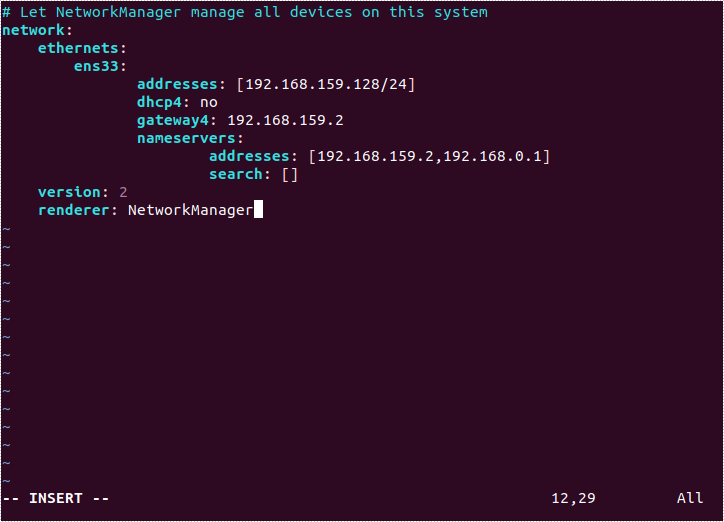
Use the script netplan apply to apply the network settings, and use the script ifconfig -a to check if the IP address is successfully applied.

Step 2. Copy Spire.Cloud.Office to Ubuntu
Download Spire.Cloud.Office for Linux package, and unzip it somewhere on your disk. We'll use WinSCP to copy files from Windows system to the root of Ubuntu system.
1) Log in to WinSCP

If the connection fails and an error appears as shown in the figure below, please check whether sshd is installed on the server.
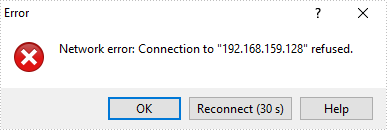
If not installed, refer to the following solution:
First, run the script apt-get install yum, and then enter Y to continue.

Secondly, run the script apt-get install openssh-server, and enter Y to continue.

Finally, run the script ps -e|grep ssh, and you'll see sshd has been successfully installed.

By default, the root user is not allowed to perform SSH remote login. You can enter the configuration file using vim /etc/ssh/sshd_config, change PermitRootLogin to yes, and then run service sshd restart to activate the setting.
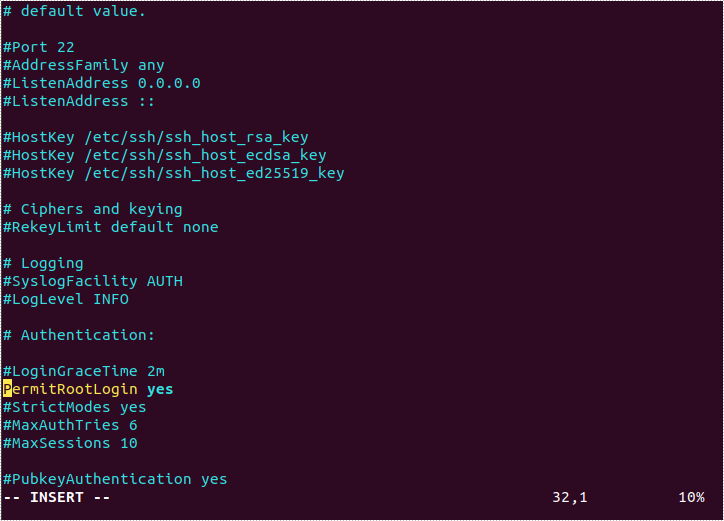
2) Copy files
After the connection is successful, copy the files contained in Spire.Cloud.Office for Linux package to the /root/cloud/ directory of the Ubuntu system. The "cloud" folder here is a newly created folder and can be named arbitrarily.

Step 3. Install Spire.Cloud.Office for Linux
Enter the folder where the file "install_ubuntu18.04.sh" is located, then run the script bash install_ubuntu18.04.sh to install Spire.Cloud.Office on Ubuntu.

After the installation is completed, you'll get the following output.
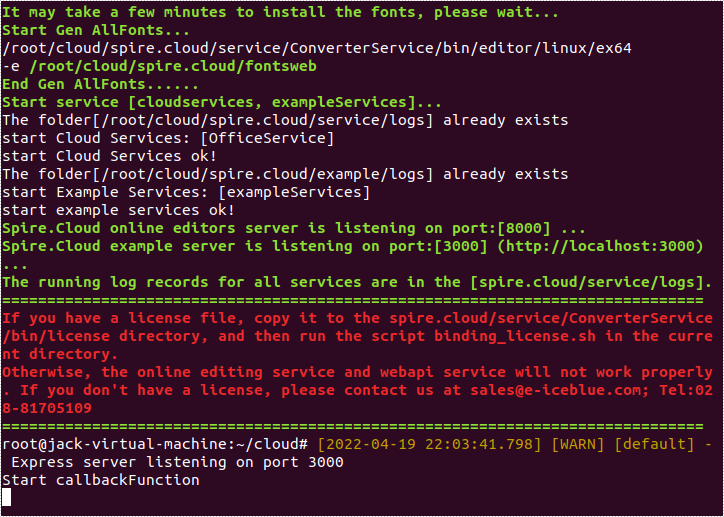
Step 4. Bind License
Copy your license file to the /root/cloud/spire.cloud/service/ConverterService/bin/license/ directory through WinSCP. If you need a temporary license to evaluate our product, please contact sales.
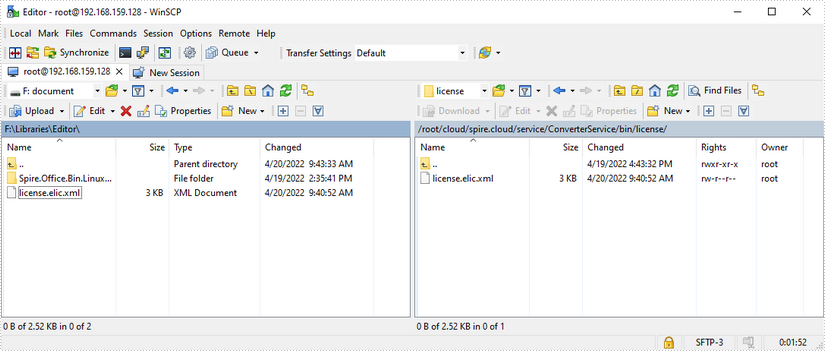
Enter the folder that contains the file "binding_license.sh", then run the script bash binding_license.sh to bind the license.

After the license is successfully bound, you'll get the following output.

Now that you've successfully installed Spire.Cloud.Office for Linux on Ubuntu, you can visit our example on port 3000, or you can embed the document editor in your HTML page using JavaScript.

Install Spire.Cloud.Office on Windows
Spire.Cloud.Office is an Office suite that contains online editors for Word and Excel documents. It can be installed on your local server and integrated into your own web application to view, create & edit Word and Excel documents. This guide will teach you how to install Spire.Cloud.Office on Windows system.
Step 1. Install Spire.Cloud.Office
1) Download the installer of Spire.Could.Office for Windows.
2) Turn off the antivirus program if you have any.
3) Run the installer and follow the wizard steps.
Choose "I accept the agreement" and press "Next".
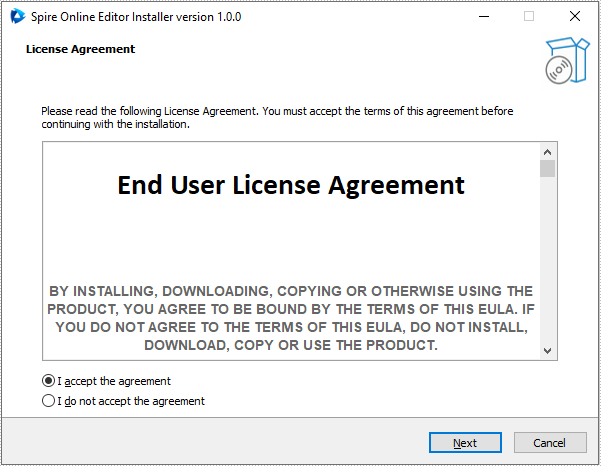
Set install location and go to the next step. Please make sure that your user account has appropriate permissions to access the specified installation directory, otherwise you may fail to bind the license later.
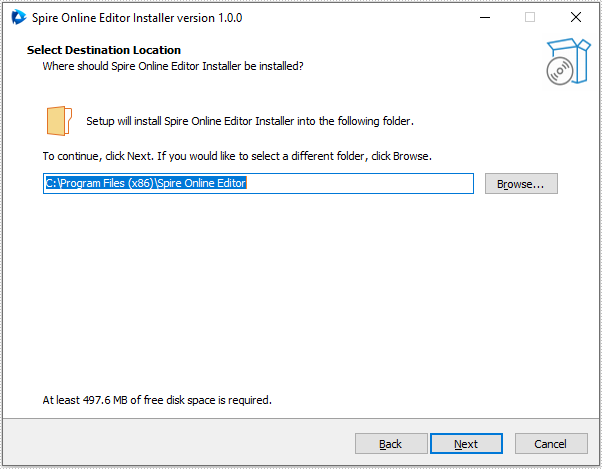
Press "Install" to install Spire.Cloud.Office for .NET to the specified location.
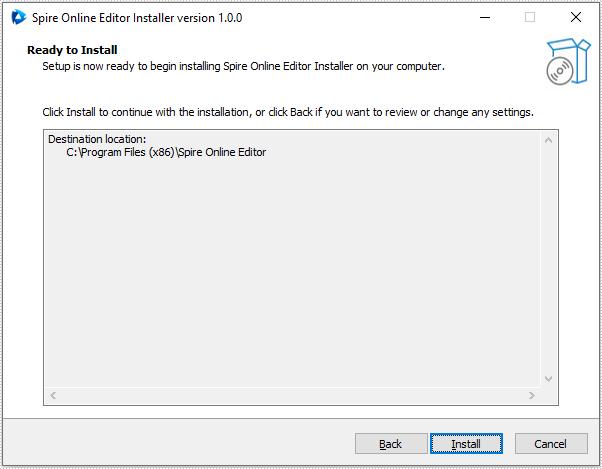
Press "Next" to accomplish system checking and fonts’ installation.
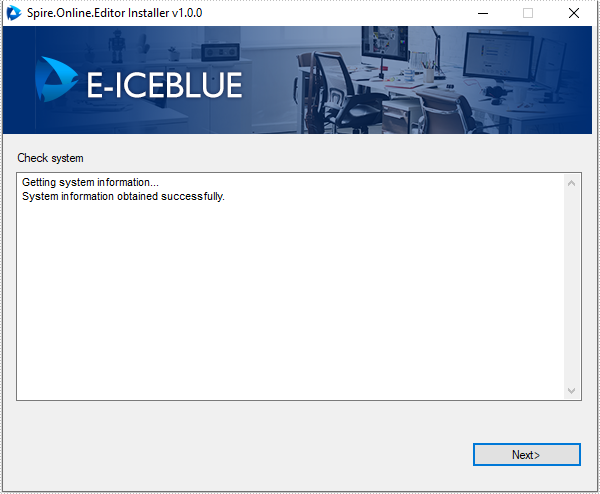
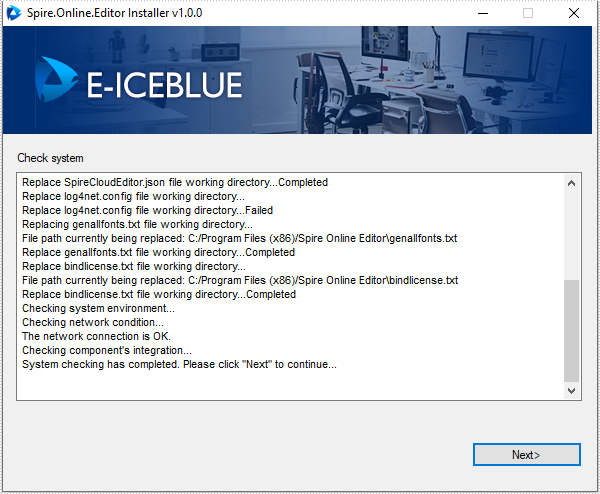
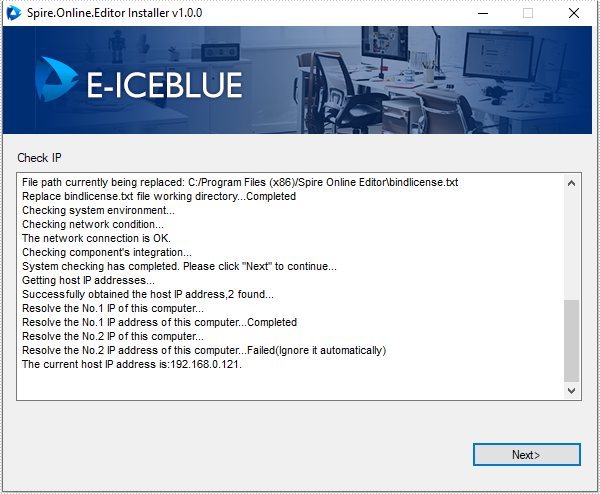
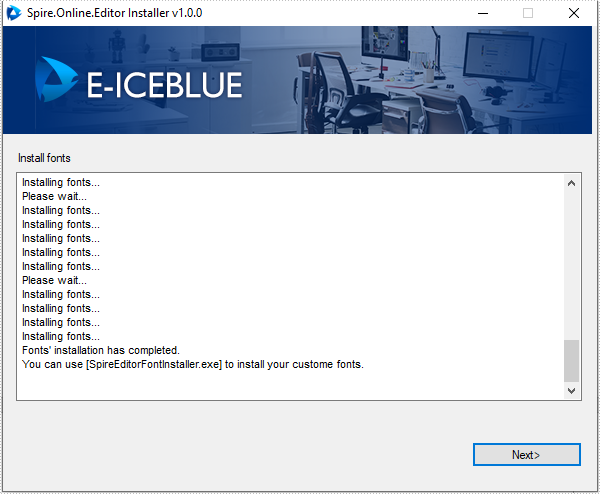
Press "Start service" to start the service and then click "Finish" to finish the installation.
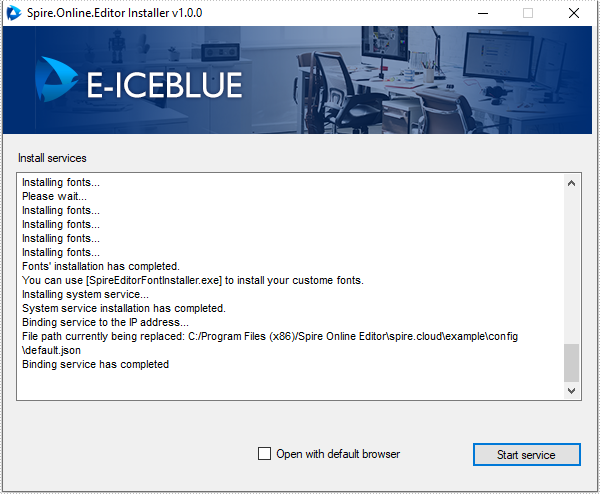
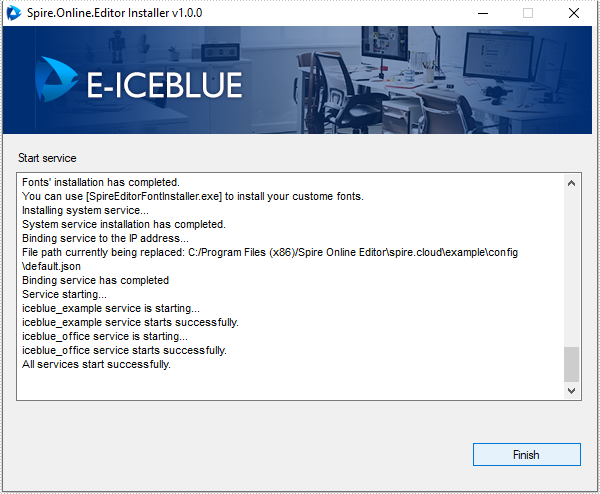
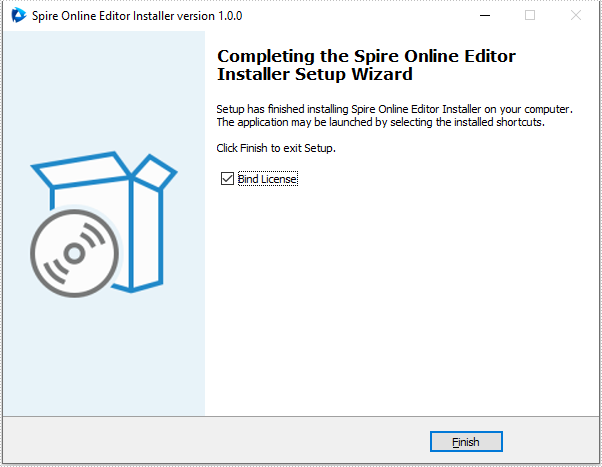
Step 2. Bind License
A license is required to run Spire.Cloud.Office for .NET editor, please contact our sales department ([email protected]) to request one. Then follow the steps below to bind the license.
Drag the license (license.elic.xml) to the wizard or press "Choose" to choose the license from your system.
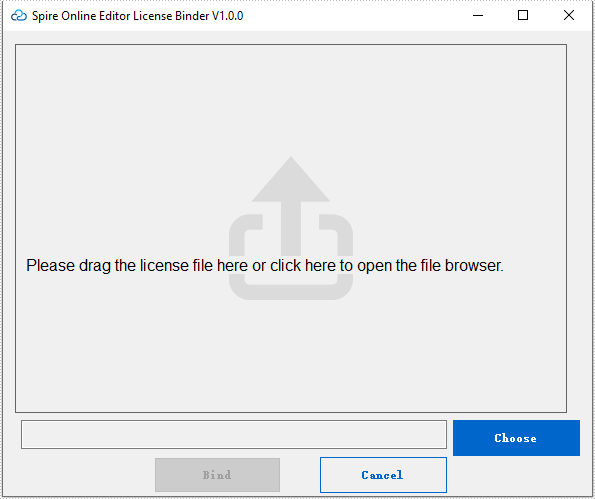
Press "Bind" to bind the license.

After the license binding has completed, press "Exit" to quit the wizard.
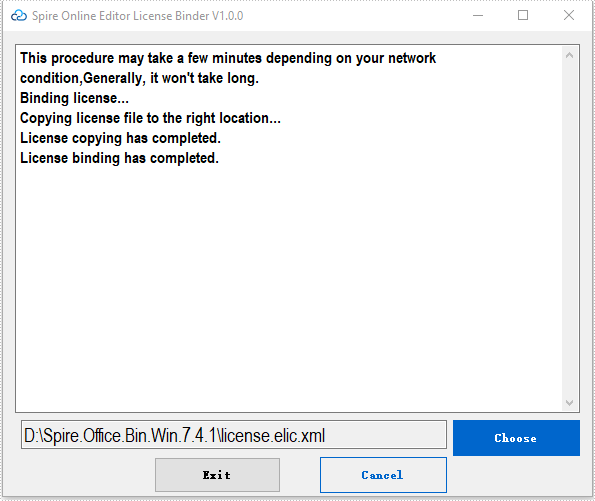
Now, Spire.Cloud.Office for .NET is ready for use. If you type "[your server ip]:3000" (in this article, we use 192.168.0.121:3000) in your browser's address bar and press enter, the following page will appear:

You can upload an existing Word/Excel file or create a new one from scratch by selecting the "Upload File" or "Create Document/Spreadsheet" option. Here we upload an existing Word file:
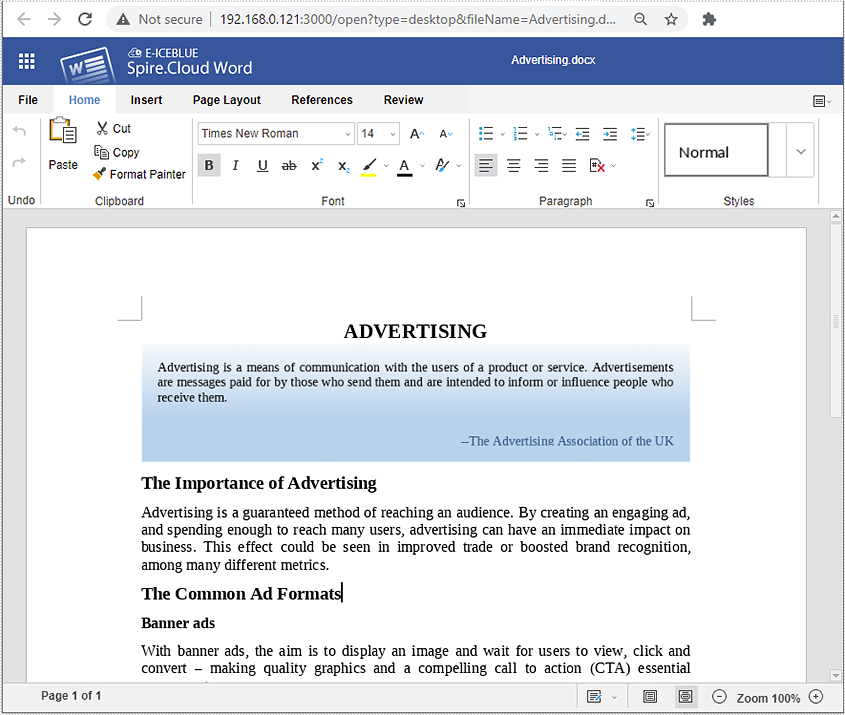
Spire.PDF 8.4.15 enhances the conversion from PDF to Word and PDF to images
We are glad to announce the release of Spire.PDF 8.4.15. This version enhances the conversion from PDF to Word and PDF to images. In addition, it fixes some known issues such as the memory consumption wasn't release immediately after merging PDF files. More details are listed below.
Here is a list of changes made in this release
| Category | ID | Description |
| Bug | SPIREPDF-349 SPIREPDF-372 SPIREPDF-377 |
Fixes the issue that the content was incorrect after converting XPS to PDF. |
| Bug | SPIREPDF-386 | Fixes the issue that the application threw "OutOfMemoryException" when converting XPS to PDF. |
| Bug | SPIREPDF-438 | Fixes the issue that the signature wasn't display after signing in PDF field. |
| Bug | SPIREPDF-668 | Fixes the issue that the color was incorrect after converting PDF to image. |
| Bug | SPIREPDF-794 | Fixes the issue that the output effect was incorrect after adding background image and setting a value for the BackgroudOpacity. |
| Bug | SPIREPDF-1118 | Fixes the issue that the output effect was incorrect after merging PDF files. |
| Bug | SPIREPDF-4934 | Fixes the issue that the output was garbled when drawing "€" with Net5.0. |
| Bug | SPIREPDF-4953 | Fixes the issue that there was a blank page when drawing the created template. |
| Bug | SPIREPDF-4984 | Fixes the issue that the application threw "System.ArgumentOutOfRangeException" when converting PDF to image. |
| Bug | SPIREPDF-5009 | Fixes the issue that the saved image didn't have been rotated after rotating PDF page. |
| Bug | SPIREPDF-5012 | Fixes the issue that there were extra spaces after extracting PDF page text. |
| Bug | SPIREPDF-5014 | Fixes the issue that the memory consumption wasn't release immediately after merging PDF files. |
| Bug | SPIREPDF-5031 | Fixes the issue that the application threw "IndexOutOfRangeException" when converting PDF to Word. |
| Bug | SPIREPDF-5072 | Fixes the issue that the content was incorrect after deleting images. |
Spire.Doc 10.4.5 enhances the conversion from Word to PDF and HTML to Word
We are pleased to announce the release of Spire.Doc 10.4.5. This version enhances the conversion from Word to PDF as well as HTML to Word. In addition, it fixes some known issues such as the output effect was incorrect after filling image to TextBox. More details are listed below.
Here is a list of changes made in this release
| Category | ID | Description |
| Bug | SPIREDOC-6781 SPIREDOC-7496 |
Fixes the issue that the content was lost after converting Word to PDF. |
| Bug | SPIREDOC-6922 | Fixes the issue that there was an extra blank page after converting Word to PDF. |
| Bug | SPIREDOC-7276 | Fixes the issue that it was failed to open the saved Word file after loading and saving directly. |
| Bug | SPIREDOC-7358 SPIREDOC-7622 |
Fixes the issue that the content was incorrect after converting Word to PDF. |
| Bug | SPIREDOC-7375 | Fixes the issue that the application threw "System.StackOverflowException" when comparing Word files. |
| Bug | SPIREDOC-7451 | Fixes the issue that the table height was incorrect after converting Html to Word. |
| Bug | SPIREDOC-7539 | Fixes the issue that the application threw "System.FormatException" when loading Html. |
| Bug | SPIREDOC-7565 | Fixes the issue that the application threw "System.NullReferenceException" when converting Word to PDF. |
| Bug | SPIREDOC-7593 | Fixes the issue that the Math displayed incorrectly after converting Html to Word. |
| Bug | SPIREDOC-7598 | Fixes the issue that the decimal point('.') was lost after converting Word to PDF. |
| Bug | SPIREDOC-7621 | Fixes the issue that the output effect was incorrect after filling image to TextBox. |
Spire.Presentation 7.4.5 supports getting the number format of ChartData
We are glad to announce the release of Spire.Presentation 7.4.5. This version supports getting the number format of ChartData, and enhances the conversion from PowerPoint to PDF. In addition, it fixes some known issues such as the saved background image was incorrect. More details are listed below.
Here is a list of changes made in this release
| Category | ID | Description |
| New feature | SPIREPPT-1905 | Supports getting the number format of ChartData.
Presentation ppt = new Presentation(); ppt.LoadFromFile(@"input.pptx", Spire.Presentation.FileFormat.Pptx2013); IChart chart = ppt.Slides[1].Shapes[0] as IChart; var numberFormat = chart.ChartData[1, 1].NumberFormat; |
| Bug | SPIREPPT-518 | Fixes the issue that the text line format was lost after converting PowerPoint to PDF. |
| Bug | SPIREPPT-939 | Fixes the issue that the compared result was different when comparing two PowerPoint files themselves have the same master. |
| Bug | SPIREPPT-1721 | Fixes the issue that the previous series format was lost after adding new series to the Chart. |
| Bug | SPIREPPT-1844 | Fixes the issue that the application threw "System.NullReferenceException" when saving the PowerPoint file that copied slides. |
| Bug | SPIREPPT-1859 | Fixes the issue that the application threw "System.ArgumentException" when adding Html to PowerPoint file. |
| Bug | SPIREPPT-1872 | Fixes the issue that the content format was incorrect after converting PowerPoint file to PDF. |
| Bug | SPIREPPT-1883 | Fixes the issue that the Series.Distance setting didn't take effect. |
| Bug | SPIREPPT-1889 | Fixes the issue that the content format was incorrect after converting PowerPoint file to image when region sets to German (DE). |
| Bug | SPIREPPT-1898 | Fixes the issue that the application threw "System.NullReferenceException" when getting font color of the table text. |
| Bug | SPIREPPT-1904 | Fixes the issue that the saved background image was incorrect. |
| Bug | SPIREPPT-1913 | Fixes the issue that the application threw "System.ArgumentOutOfRangeException" when adding Html to PowerPoint file |
Spire.XLS for Java 5.4.3 supports setting a maximum number of pages to convert when converting Excel file to PDF
We are happy to announce the release of Spire.XLS for Java 5.4.3. This version supports setting a maximum number of pages to convert when converting Excel file to PDF, and enhances the conversion from Excel to PDF, Excel to PDFA, Excel to HTML. In addition, it fixes some known issues such as the output file was failed to open after adding watermark to an Excel file. More details are listed below.
Here is a list of changes made in this release
| Category | ID | Description |
| New feature | - | Supports setting a maximum number of pages to convert when converting Excel file to PDF.
workbook.loadFromFile(inputFile); //Fit to page workbook.getConverterSetting().setSheetFitToPage(true); //Set the maximum number of pages to convert workbook.getConverterSetting().setMaxConvertPages(); //Save to PDF file workbook.saveToFile(outputFile, FileFormat.PDF); workbook.dispose(); |
| New feature | SPIREXLS-3763 | Supports using ApplyStyle() to apply the style for a cell range.
//Create a Workbook object
Workbook workbook = new Workbook();
//Load a sample Excel file
workbook.loadFromFile("in.xlsx");
//Get the first worksheet
Worksheet sheet = workbook.getWorksheets().get(0);
//Create a CellStyle object
CellStyle fontStyle = workbook.getStyles().addStyle("headerFontStyle");
//Set the font color, size and style
fontStyle.getFont().setColor(Color.white);
fontStyle.getFont().isBold(true);
fontStyle.getFont().setSize(12);
fontStyle.setHorizontalAlignment(HorizontalAlignType.Center);
CellStyleFlag flag = new CellStyleFlag();
flag.setFontColor(true);
flag.setFontBold(true);
flag.setFontSize(true);
flag.setHorizontalAlignment(true);
//Apply style
sheet.getRange().get(1, 1, 1, 8).applyStyle(fontStyle, flag);
workbook.saveToFile("out.xlsx", ExcelVersion.Version2016);
|
| Bug | SPIREXLS-3730 | Fixes the issue that the application threw "Illegal characters in path" error when converting Excel file to Html. |
| Bug | SPIREXLS-3731 | Fixes the issue that the content was lost after converting Excel file to PDF. |
| Bug | SPIREXLS-3733 | Fixes the issue that the application threw " java.lang.IllegalAccessError" when converting Excel file to PDF with openjdk17. |
| Bug | SPIREXLS-3741 | Fixes the issue that the application hung a long time when converting Excel file to PDF. |
| Bug | SPIREXLS-3671 | Fixes the issue that the formula calculated incorrectly and some Chinese text was garbled after converting Excel file to PDF. |
| Bug | SPIREXLS-3755 | Fixes the issue that the output file was failed to open after adding watermark to an Excel file. |
| Bug | SPIREXLS-3761 | Fixes the issue that the transparency verification failed after converting Excel file to PDFA and doing a pre-flight checking in Adobe PDF. |
| Bug | SPIREXLS-3766 | Fixes the issue that the application threw "NullPointerException" when saving Excel file. |
Spire.XLS 12.4.1 supports converting Pareto, Sunburst, Histogram charts of Chart2016 when converting Excel to PDF and image
We are happy to announce the release of Spire.XLS 12.4.1. This version supports converting Pareto, Sunburst, Histogram charts of Chart2016 in the function of converting Excel to PDF and Image, and enhances the conversion from Excel to HTML and Excel to CSV. In addition, it fixes some known issues such as the application threw "Invalid cell name" when loading an Excel file. More details are listed below.
Here is a list of changes made in this release
| Category | ID | Description |
| New feature | - | In the functions of converting Excel to PDF and Image, added supports converting Pareto, Sunburst, Histogram charts of Chart2016. |
| Bug | SPIREXLS-3654 | Fixes the issue that some cells value were incorrect after doing CalculateAllValue(). |
| Bug | SPIREXLS-3676 | Fixes the issue that the application threw "System.NullReferenceException" when loading csv file. |
| Bug | SPIREXLS-3680 | Fixes the issue that the application threw "System.ArgumentOutOfRangeException" when loading .xlsb file. |
| Bug | SPIREXLS-3709 | Fixes the issue that the text wrap effect was lost after converting Excel to Html. |
| Bug | SPIREXLS-3723 | Fixes the issue that the PDF content converted from Excel file was garbled when opening on MAC system. |
| Bug | SPIREXLS-3732 | Fixes the issue that the output effect of replacing text with image was incorrect when system DPI sets as 125%. |
| Bug | SPIREXLS-3737 | Fixes the issue that the application threw "Invalid cell name" when loading an Excel file. |
| Bug | SPIREXLS-3742 | Fixes the issue that the output effect was incorrect after converting Excel to CSV. |
| Bug | SPIREXLS-3754 | Fixes the issue that some datas was unable to display even setting AllocatedRange.AutoFitColumns() and AllocatedRange.AutoFitRows(). |
| Bug | SPIREXLS-3757 | Fixes the issue that the 'AutoFitColumn' setting didn't take effect. |
Java: Set Background Color and Pattern for Excel Cells
When working with an Excel document that contains a lot of data, setting color or pattern for selected cells can make it very easy for users to locate specific types of information. In Microsoft Excel, you can achieve this function by simply clicking the "Fill Color" button on the formatting toolbar. In this article, you will learn how to programmatically set background color and pattern style for a specified cell or cell range in Excel using Spire.XLS for Java.
Install Spire.XLS for Java
First, you're required to add the Spire.Xls.jar file as a dependency in your Java program. The JAR file can be downloaded from this link. If you use Maven, you can easily import the JAR file in your application by adding the following code to your project's pom.xml file.
<repositories>
<repository>
<id>com.e-iceblue</id>
<name>e-iceblue</name>
<url>https://repo.e-iceblue.com/nexus/content/groups/public/</url>
</repository>
</repositories>
<dependencies>
<dependency>
<groupId>e-iceblue</groupId>
<artifactId>spire.xls</artifactId>
<version>15.6.3</version>
</dependency>
</dependencies>
Set Background Color and Pattern for Excel Cells
The detailed steps are as follows.
- Create a Workbook object.
- Load a sample Excel document using Workbook.loadFromFile() method.
- Get a specified worksheet using Workbook.getWorksheets().get() method.
- Get a specified cell range using Worksheet.getRange().get() method.
- Set background color for the specified cell range using CellRange.getStyle().setColor() method.
- Set fill pattern style for the specified cell range using CellRange.getStyle().setFillPattern() method.
- Save the result to another file using Workbook.saveToFile() method.
- Java
import com.spire.xls.*;
import java.awt.*;
public class CellBackground {
public static void main(String[] args) {
//Create a Workbook object
Workbook workbook = new Workbook();
//Load a sample Excel document
workbook.loadFromFile("C:\\Users\\Administrator\\Desktop\\data.xlsx");
//Get the first worksheet
Worksheet worksheet= workbook.getWorksheets().get(0);
//Set background color for range "A1:E1" and "A2:A10"
worksheet.getRange().get("A1:E1").getStyle().setColor(Color.green);
worksheet.getRange().get("A2:A10").getStyle().setColor(Color.yellow);
//Set background color for cell E8
worksheet.getRange().get("E8").getStyle().setColor(Color.red);
//Set fill pattern style for range "C4:D5"
worksheet.getRange().get("C4:D5").getStyle().setFillPattern(ExcelPatternType.Percent25Gray);
//Save the document
workbook.saveToFile("CellBackground.xlsx", ExcelVersion.Version2013);
}
}
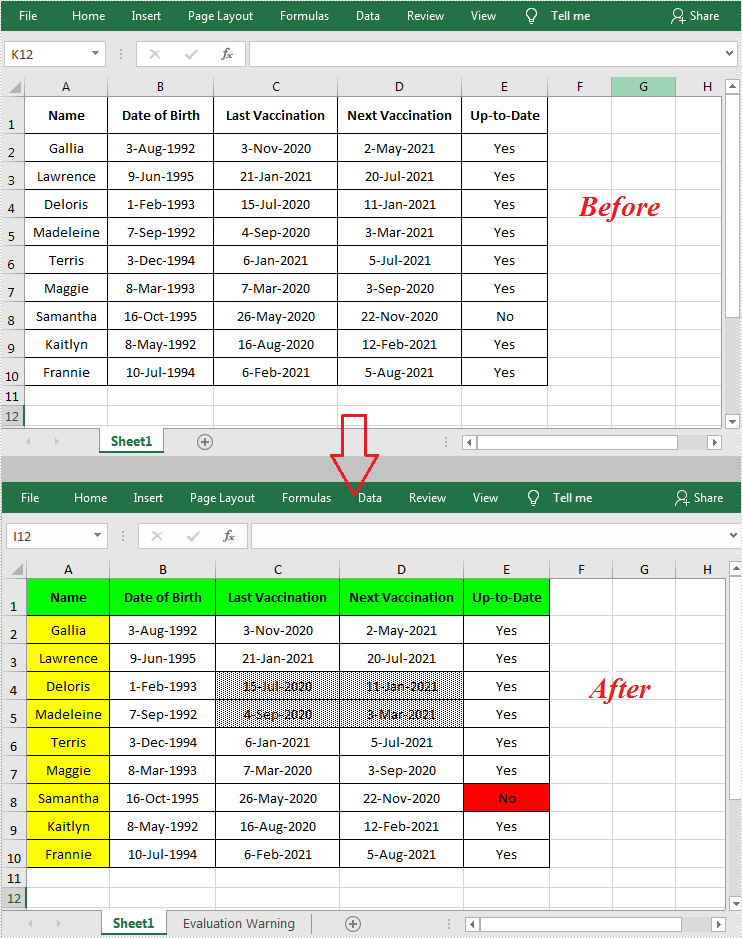
Apply for a Temporary License
If you'd like to remove the evaluation message from the generated documents, or to get rid of the function limitations, please request a 30-day trial license for yourself.
Spire.Office for Java 5.4.2 is released
We are excited to announce the release of Spire.Office for Java 5.4.2. This version brings some new features. For instance, Spire.Doc for Java supports converting Word documents using NewEngine, it also enhances the conversion from Word to PDF, Word to HTML, Word to OFD, XML to Word and Word to image; Spire.PDF for Java enhances the conversion from PDF to Word, PDF to PDFA; Spire.Presentation for Java enhances the conversion from PowerPoint to PDF Meanwhile, a lot of bugs have been successfully fixed. More details are listed as follow.
Here is a list of changes made in this release
Spire.Doc for Java
| Category | ID | Description |
| New feature | - | Supports converting Word documents using NewEngine.
Document doc = new Document(); doc.loadFromFile(inputFile); doc.setUseNewEngine(true); |
| Bug | SPIREDOC-6385 SPIREDOC-7011 SPIREDOC-7380 |
The NewEngine method fixes the issue that the image position offset after converting Word file to PDF. |
| Bug | SPIREDOC-6863 SPIREDOC-6879 SPIREDOC-6918 SPIREDOC-6989 SPIREDOC-6993 SPIREDOC-7004 SPIREDOC-7043 SPIREDOC-7152 SPIREDOC-7219 SPIREDOC-7319 SPIREDOC-7368 SPIREDOC-7371 SPIREDOC-7438 SPIREDOC-7481 SPIREDOC-7483 SPIREDOC-7537 |
The NewEngine method fixes the issue that the content format was incorrect after converting Word file to PDF. |
| Bug | SPIREDOC-6956 | The NewEngine method fixes the issue that the application threw "Exception in thread "main" class com.spire.office.packages.sprpfe" when converting Word file to PDF. |
| Bug | SPIREDOC-6996 | The NewEngine method fixes the issue that the application threw "An element with the same key already exists in the dictionary" when converting Word file to PDF. |
| Bug | SPIREDOC-7028 | The NewEngine method fixes the issue that the application threw "IllegalArgumentException" when converting Word file to PDF. |
| Bug | SPIREDOC-7071 | The NewEngine method fixes the issue that the application hanged a long time when converting Word file to PDF. |
| Bug | SPIREDOC-7111 SPIREDOC-7569 |
The NewEngine method fixes the pagination was incorrect after converting Word file to PDF. |
| Bug | SPIREDOC-7246 | The NewEngine method fixes the content was lost after converting Word file to PDF. |
| Bug | SPIREDOC-7249 | The NewEngine method fixes the issue that the application threw "StackOverflowError" when converting Word file to PDF. |
| Bug | SPIREDOC-7255 SPIREDOC-7271 SPIREDOC-7418 |
The NewEngine method fixes the text wrap was incorrect after converting Word file to PDF. |
| Bug | SPIREDOC-7277 SPIREDOC-7369 SPIREDOC-7408 |
The NewEngine method optimizes the time consumption when converting Word file to PDF. |
| Bug | SPIREDOC-7308 | The NewEngine method fixes the image was overlapped after converting Word file to PDF. |
| Bug | SPIREDOC-7360 | The NewEngine method fixes the image was lost after converting Word file to PDF. |
| Bug | SPIREDOC-7519 | The NewEngine method fixes the issue that there was an extra blank pages after converting Word file to PDF. |
| Bug | SPIREDOC-4270 | Fixes the issue that the content was overlapped after converting word file to PDF. |
| Bug | SPIREDOC-6749 | Fixes the issue that the application threw "Specified argument was out of the range" when converting word file to PDF. |
| Bug | SPIREDOC-7198 SPIREDOC-7415 |
Fixes the issue that the content format was incorrect after converting word file to PDF. |
| Bug | SPIREDOC-7243 | The NewEngine method fixes the issue that the content position was incorrect after converting word file to PDF. |
| Bug | SPIREDOC-7259 | Fixes the issue that the table position was incorrect after converting word file to PDF. |
| Bug | SPIREDOC-7274 | Fixes the issue that the font was incorrect after converting word file to PDF. |
| Bug | SPIREDOC-7376 | Fixes the issue that the table borders were lost after converting word file to PDF. |
| Bug | SPIREDOC-7399 SPIREDOC-7487 |
Fixes the issue that the pagination was incorrect after converting word file to PDF. |
| Bug | SPIREDOC-7426 | Fixes the issue that there was extra underline after converting word file to Html. |
| Bug | SPIREDOC-7436 SPIREDOC-7516 |
Fixes the issue that the table content was incorrect after converting word file to Html. |
| Bug | SPIREDOC-7479 | Fixes the issue that the application threw "NullPointerException" when converting word file to PDF. |
| Bug | SPIREDOC-7480 | Fixes the issue that the application threw "NullPointerException" when converting word file to Html. |
| Bug | SPIREDOC-7484 | Fixes the issue that there were extra black lines after converting word file to image. |
| Bug | SPIREDOC-7486 | Fixes the issue that the application threw "The string contains invalid characters" when converting xml to word. |
| Bug | SPIREDOC-7488 | Fixes the issue that the content was lost after converting word file to PDF. |
| Bug | SPIREDOC-7492 | Fixes the issue that the image path was unable to be found when setting setImagesPath to convert word to Html in Linux system. |
| Bug | SPIREDOC-7513 | Fixes the issue that the application threw "span' is expected Line 1, position 1160331" when loading a word file. |
| Bug | SPIREDOC-7518 | Fixes the issue that the mailMerge was failed when setting the property access to "private". |
| Bug | SPIREDOC-7527 | Fixes the issue that the application threw "StackOverflowError" when comparing word files. |
| Bug | SPIREDOC-7532 | Fixes the issue that the content format was incorrect after converting word file to OFD. |
Spire.PDF for Java
| Category | ID | Description |
| Bug | SPIREPDF-4966 SPIREPDF-5003 |
Fixes the issue that the Chinese characters were garbled after converting PDF to PDFA. |
| Bug | SPIREPDF-4969 | Fixes the issue that the application threw "NullPointerException" when converting PDF to word. |
| Bug | SPIREPDF-4971 | Fixes the issue that the application threw "ArrayIndexOutOfBoundsException" when converting PDF to PDFA repeatedly. |
| Bug | SPIREPDF-4973 | Fixes the issue that the application threw " Can't append a node created by another document" when converting PDF to OFD with multithreads. |
| Bug | SPIREPDF-4978 | Fixes the issue that the application threw " NullPointerException" when getting PDF first page. |
| Bug | SPIREPDF-4992 | Fixes the issue that the content format was incorrect after converting PDF to PDFA. |
| Bug | SPIREPDF-5010 | Fixes the issue that it was unable to set font for PdfCode128ABarcode bottom text. |
Spire.Presentation for Java
| Category | ID | Description |
| Bug | SPIREPPT-1884 | Fixes the issue that the application threw "ExecutionException" when converting PPT to PDF in Mac system. |
| Bug | SPIREPPT-1888 | Optimizes the time consumption when converting PPT file to PDF. |
| Bug | SPIREPPT-1894 | Fixes the issue that the application threw "NullPointerException" when getting the numbers of chart Categories. |
